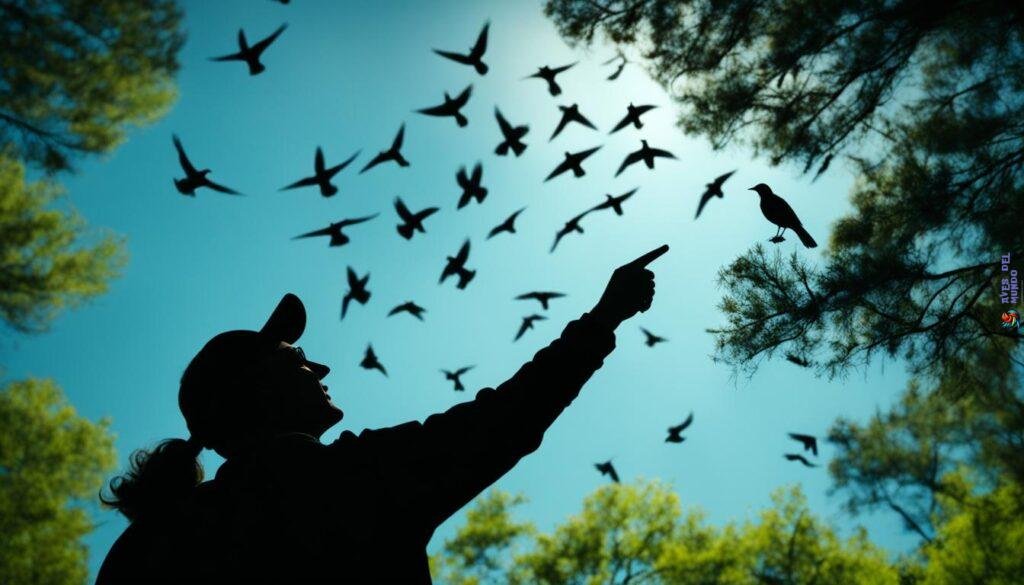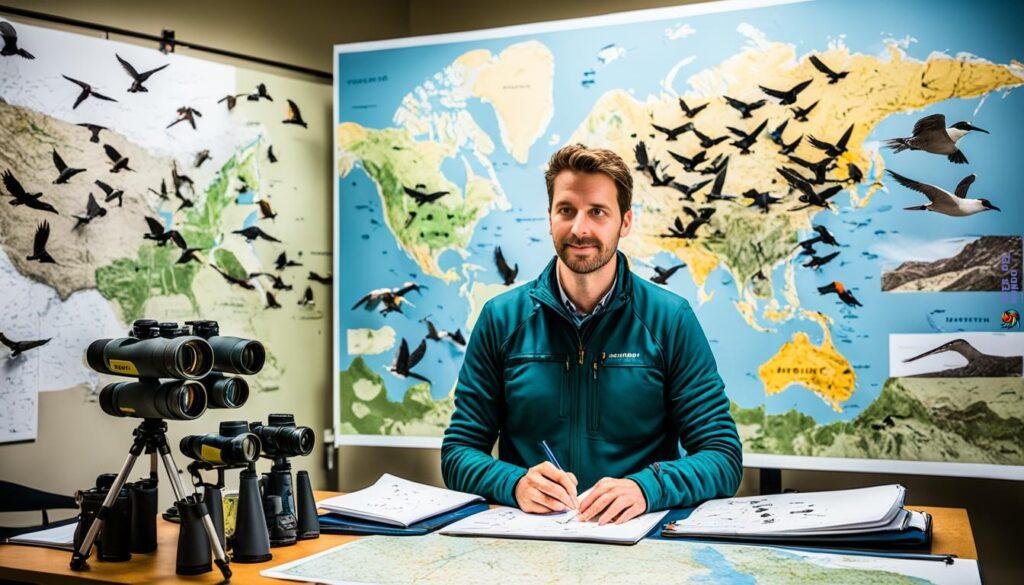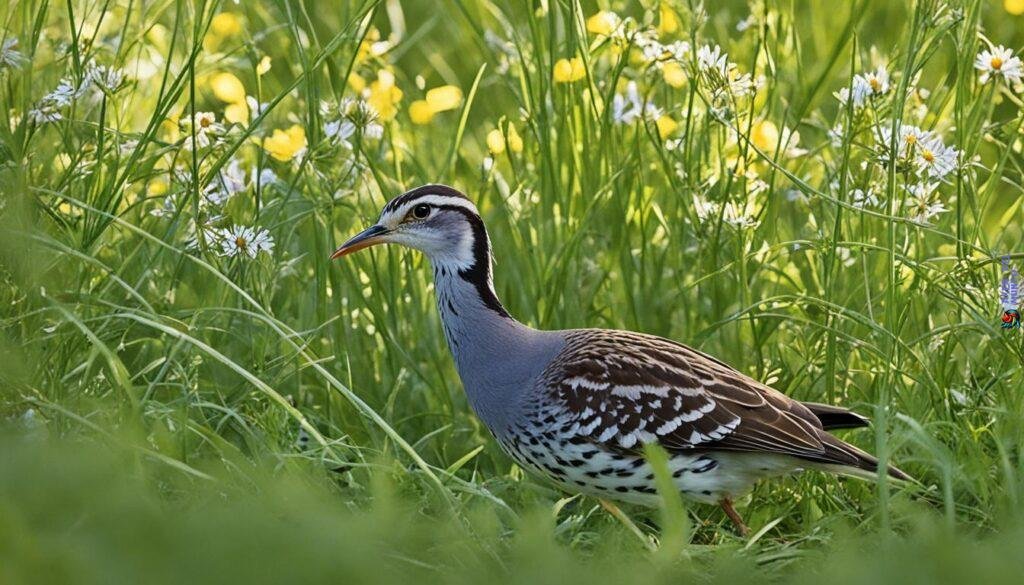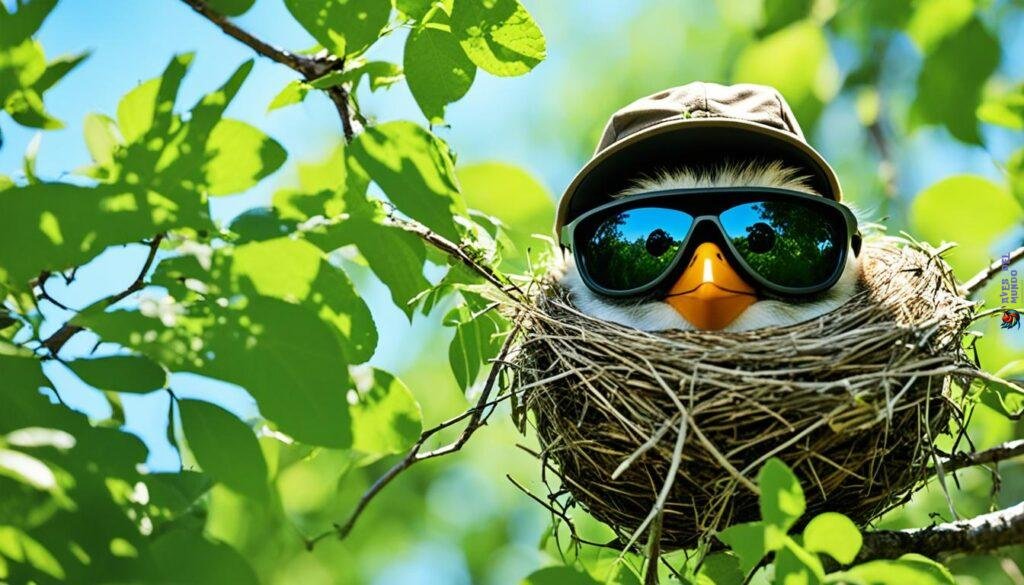Did you know that bird nests come in a variety of shapes and sizes, reflecting the remarkable diversity of avian species? From intricately woven cup nests to burrows in the ground, these structures serve as homes and nurseries for birds worldwide. Exploring the fascinating world of bird nests can offer insights into the lives of our feathered friends.
But when it comes to observing bird nests, it’s crucial to prioritize safety and minimize disturbance. Whether you’re interested in bird nest identification, bird nest facts, or simply capturing bird nest pictures, this guide will provide you with valuable tips to observe nests responsibly.
Why Learning About Birds is Important for Nest Monitoring?
Learning about birds is essential for successful nest monitoring. Understanding their nesting behaviors will enhance your ability to find nests and monitor them safely. By acquiring knowledge about different bird species, you can improve your nest-finding and monitoring skills, ultimately contributing valuable data to the NestWatch database. Additionally, your observations can provide crucial insights to researchers, helping them understand the threats facing breeding birds and develop effective conservation strategies.
To enhance your understanding of birds and their nesting behavior, utilize credible resources like the Cornell Lab of Ornithology’s All About Birds and the Birds of the World online database. These platforms provide comprehensive information about various bird species, including their nesting habits, migration patterns, and preferred habitats. By familiarizing yourself with these resources, you’ll be equipped with the knowledge necessary to identify nests and monitor them responsibly.

«Learning about birds enables you to unlock the secrets of their nesting lives, empowering you to contribute meaningfully to bird conservation.»
Developing nest-finding skills will help you locate nests without causing unnecessary disturbance. Different bird species have unique nesting preferences, ranging from tree cavities and shrubs to the ground. By understanding these preferences and recognizing nesting signs such as territorial behavior and strategic nest placements, you can effectively discover nests while minimizing any potential harm.
Moreover, acquiring monitoring skills ensures that you collect accurate and reliable data during your nest observations. This includes properly recording nest location, identifying the species, and documenting important details such as nest contents and nesting attempts. The more precise your data, the better researchers can comprehend the dynamics of bird populations, identify threats, and formulate conservation strategies.
Planning and Preparation for Nest Observations
When it comes to monitoring nests, proper planning and preparation are key to ensuring accurate and meaningful data collection. By following the NestWatch protocol and being well-prepared, you can contribute valuable information to the NestWatch database and assist in bird conservation efforts.
- Make a plan: Before embarking on nest observations, it’s essential to create a plan that outlines your monitoring schedule and goals. Decide how frequently you will monitor nests, keeping in mind that even weekly checks can provide valuable data. This plan will help you stay organized and ensure consistent monitoring throughout the nesting season.
- Use the NestWatch protocol: The NestWatch protocol provides a standardized approach to nest monitoring, ensuring that data collected by volunteers is reliable and comparable. Familiarize yourself with the protocol guidelines to ensure accurate and consistent data collection.
- Prepare materials: Before heading out to visit nests, gather the necessary materials to record your observations. Consider using datasheets, notebooks, or a mobile app specifically designed for nest monitoring. Having these materials ready beforehand will help streamline the data collection process and minimize errors.
- Keep visits brief: When visiting nests, it’s important to keep your presence as brief as possible to minimize disturbance to the birds. Aim for nest visits that last no longer than one minute, allowing you to gather essential information without causing unnecessary stress to the nesting birds.
| Materials for Nest Observations | Advantages |
|---|---|
| Datasheets | Provides a structured format for data recording |
| Notebooks | Allows for detailed field notes and sketches |
| Mobile app | Enables efficient data collection and immediate database submission |
By planning ahead and being well-prepared, you can make the most out of your nest observations and contribute valuable data to ongoing research. Remember, your efforts play a crucial role in understanding and conserving bird populations for future generations.

Collecting Accurate Data for NestWatch Database
To contribute to the NestWatch database and support research on breeding birds, it is essential to collect accurate and precise data during your nest observations. By documenting key information such as nest location, species identification, nest contents, and nesting attempt summary, you can provide valuable insights into bird behavior and contribute to conservation efforts.
When recording nest data, pay close attention to the following details:
- Nest Location: Take note of the exact location where the nest is situated. This could include the type of habitat, vegetation, or specific landmarks surrounding the nest.
- Species Identification: Try to identify the bird species inhabiting the nest accurately. If you are unsure, consider using field guides or online resources to aid in species recognition.
- Nest Contents: Document the number of eggs, nestlings, or fledglings observed during each visit. This information helps researchers understand the reproductive success rates of different bird species.
- Nesting Attempt Summary: Provide a summary of the nesting attempt once it is complete. Note any significant events or outcomes, such as nest failure, fledgling success, or predation incidents. This information enhances our understanding of the challenges faced by breeding birds.
By collecting and submitting accurate nest data, you are actively contributing to the NestWatch database and helping researchers gain insights into the breeding biology of various bird species. Your contributions play a crucial role in shaping conservation strategies and protecting our avian friends.

Choosing the Right Time to Visit Nests
When it comes to observing bird nests, timing is key to ensure minimal disturbance. By choosing the optimal time to visit nests, you can avoid disrupting crucial stages of the nesting process and safeguard the well-being of the birds and their young. Here are some essential guidelines to follow:
- Avoid early morning visits: In the early morning, birds are often busy laying eggs and may temporarily leave the nest. It’s best to wait until the female bird has left the nest before approaching.
- Be mindful during incubation: During the incubation stage, it’s important to wait for the first few days before approaching the nest. This allows the female bird to establish a routine and feel more comfortable leaving the nest temporarily.
- Steer clear during the fledging stage: The fledging stage is when young birds start to leave the nest. Avoid disturbing nests during this time, as your presence may cause premature fledging, putting the young birds at risk.
- Postpone nest checks during bad weather: When the weather is unfavorable, it’s best to postpone your nest checks. Bad weather can be stressful for birds and may disrupt their nesting behavior and activities.
- Avoid dusk visits: For birds like owls that are active at dusk, it’s crucial to avoid visiting their nests at or after dusk. By respecting their natural behavior, you reduce the risk of unintentional disturbance.
By following these guidelines, you can visit bird nests at the right time, ensuring you avoid disturbance and contribute to the well-being of the birds and their nesting success.

| Optimal Time to Visit Nests | Do’s | Don’ts |
|---|---|---|
| Morning Visits | – Choose a time when female birds temporarily leave the nest – Wait for the female to leave before approaching the nest | – Disturb nests early in the morning when birds are laying eggs |
| Incubation Stage | – Wait for the first few days of incubation before approaching the nest – Give the female bird time to establish a routine | – Approach nests during the early phase of incubation |
| Fledging Stage | – Avoid disturbing nests during the fledging stage – Minimize the risk of premature fledging | – Create disturbances that may cause young birds to leave the nest prematurely |
| Bad Weather | – Postpone nest checks during unfavorable weather – Reduce stress on birds caused by the weather | – Visit nests during inclement weather |
| Dusk Visits | – Avoid visiting nests at or after dusk, especially for owl species – Respect their natural behavior | – Visit nests when owls are active at dusk |
Searching Carefully for Nests
When searching for nests, it is important to proceed with caution and care to protect nest sites and the nesting birds. Here are some tips to ensure you search carefully:
- Move slowly through dense foliage: When searching for nests, move through bushes and trees slowly and quietly. This minimizes disturbance and helps you observe any nest sites more effectively.
- Be cautious of ground-nesting birds: Some bird species, such as killdeer and sparrows, nest on the ground. Pay attention to the ground and avoid stepping on potential nest sites.
- Avoid damaging nest sites: Undiscovered nests can easily be damaged if not noticed. Take extra care when walking and avoid any unnecessary disturbance to vegetation or nesting areas.
- Minimize trampling vegetation: Walking through vegetation can cause damage and expose nests. Be mindful of where you step and try to minimize trampling plant life.
- Be cautious of nest predators: Nest predators, such as snakes and mammals, may be attracted to disturbed areas or exposed nests. Avoid leaving tracks or signs that could attract predators and disturb the nesting birds.
By searching carefully, you can avoid unintentional harm to nests and ensure the safety of the ground-nesting birds and their young. Remember, responsible observation is crucial for protecting these vulnerable creatures.

| Species | Ground-Nesting Behavior | Nest Description |
|---|---|---|
| Eastern Meadowlark | Nests on the ground in open grasslands | A cup-shaped nest made of grass and plant materials |
| Killdeer | Builds nests on the ground in open areas | Simple scrape nests lined with rocks or shells |
| Eastern Towhee | Creates nests on the ground in dense shrubs or thickets | A bulky nest made of leaves, stems, and bark strips |
Minimizing Disturbance at the Nest
When observing bird nests, it is crucial to minimize disturbance to ensure the safety and well-being of the birds and their nests. Here are a few tips to minimize disturbance:
- Approach Slowly: When approaching a nest, move slowly and quietly to avoid startling the birds. Sudden movements or loud noises can cause unnecessary stress and disturbance.
- Observe the Parent Bird: Before approaching the nest, take a moment to observe if there is a parent bird sitting on the nest. This indicates that the nest is active, and the presence of the parent bird suggests that the eggs or nestlings are being cared for.
- Wait for the Parent Bird to Leave: If there is a parent bird on the nest, wait for a few minutes to see if the bird leaves on its own. Some parent birds may temporarily leave the nest to forage or stretch their wings. Waiting for the parent bird to leave ensures that you do not disturb the nesting process.
- Brief Nest Visits: When checking the nest, keep each visit brief, lasting no longer than one minute. Limiting the duration of your visit reduces the chances of disturbing the birds or causing stress to the nestlings.
- Record Field Notes Away from the Nest: After observing the nest, wait until you are well away from the nest before recording your field notes. This reduces the risk of being too close and potentially causing further disturbance.
By following these guidelines, you can minimize disturbance at the nest and ensure a safe and stress-free environment for the nesting birds.

Handling Birds and Eggs Properly
When monitoring or observing bird nests, it is crucial to handle birds and eggs with care and responsibility. Proper permits are required for handling birds or their eggs, as this ensures that individuals handling them are appropriately trained and authorized. Handling birds and eggs without the necessary permits can lead to unintended harm to both the birds and their fragile eggs.
Eggs, in particular, are extremely delicate and can be easily cracked or damaged if mishandled. Young nestlings are also quite vulnerable and may not possess the ability to crawl back into the nest if they are accidentally displaced. It is essential to approach nests and handle eggs with caution, prioritizing the well-being of the birds and their offspring.
If children are involved in monitoring nests, they should always be supervised by an adult to ensure the safety of both the children and the nests. Adults can provide guidance and ensure that proper protocols are followed to minimize disturbance and prevent any harm.
In some cases, researchers or authorized individuals may wish to band birds or handle the contents of a nest for scientific purposes. This often requires obtaining the necessary permits, as it ensures that proper protocols and procedures are followed. Banding birds can provide valuable data for research and conservation efforts, but it should only be done by qualified individuals with the necessary permits.
Overall, it is crucial to handle birds and eggs with care and respect. By obtaining the proper permits and following established protocols, we can contribute to the understanding of bird behavior and ecology while ensuring the safety and well-being of these precious creatures.
Guidelines for Handling Birds and Eggs
| Guidelines | Description |
|---|---|
| Obtain proper permits | Ensure that appropriate permits are obtained for handling birds and eggs, as per legal requirements. |
| Handle with care | Exercise caution and gentleness when handling birds and eggs to prevent harm or damage. |
| Supervise children | Always supervise children involved in nest monitoring to ensure their safety and the safety of the nests. |
| Band birds responsibly | Band birds only with the necessary permits and following established protocols to contribute to scientific research and conservation efforts. |

Leave No Trace When Monitoring Nests
When engaging in nest monitoring activities, it is crucial to leave no trace to safeguard the nest site and protect nesting birds. By minimizing your presence and avoiding predator trails, you can help ensure the safety and well-being of the birds and their nests.
Avoiding Predator Trails
To avoid attracting predators to the nest site, it is important to take precautionary measures. When approaching and leaving a nest, be mindful of your footsteps and choose a different route away from the nest. By doing so, you reduce the chances of leaving a direct trail that may lead predators to the nest. This simple step can significantly contribute to the security of the nesting birds.
Respecting Private Land
Respecting private land is essential when monitoring nests. Always seek permission from the landowner before conducting nest searches on privately owned property. By gaining permission, you demonstrate respect for the landowner’s rights and ensure a harmonious and ethical approach to your nest monitoring activities. Additionally, make sure to follow any special requests or guidelines the landowner provides.
Obeying Laws
It is important to familiarize yourself with the laws protecting migratory birds in your region. Obeying these laws is crucial for the preservation of bird populations and their nesting habitats. Avoid physically disturbing active nests or their contents to comply with the regulations set in place for the welfare of the birds.
By following these guidelines and leaving no trace when monitoring nests, you contribute to the conservation efforts of these magnificent creatures and help ensure their continued existence in the wild.

| Key Points |
|---|
| Minimize your presence to avoid attracting predators to the nest site |
| Avoid leaving a direct trail by taking a different route away from the nest |
| Respect private land by gaining permission from the landowner before conducting nest searches |
| Obey laws protecting migratory birds and avoid physically disturbing active nests |
Understanding Nest Monitoring and Its Importance
Nest monitoring plays a crucial role in understanding the nesting behaviors of birds and their overall reproductive success. By tracking the various stages of a bird’s nesting attempt, we can gather valuable data and contribute to scientific research on avian populations. From the construction and laying of eggs to the incubation, nestling, and fledgling periods, each stage provides unique insights into the nest lifecycle.
During nest monitoring, it is essential to record accurate and detailed data, including the dates of key events such as egg-laying, hatching, and fledging. The numbers of eggs, nestlings, and fledglings should also be documented, offering a comprehensive view of the nest’s progression. Even if some visits are missed or the final outcome date is unknown, the data collected is still valuable.
Nest monitoring allows us to determine the fate of nests, whether they are successful or not. By understanding the factors that contribute to nest success or failure, researchers can develop effective conservation strategies to protect bird populations. Additionally, monitoring nests with minimal disturbance ensures that the natural nesting process is not disrupted, allowing birds to carry out their reproductive activities undisturbed.
«Nest monitoring provides valuable insights into the breeding success of different bird species. By contributing nest data, we actively contribute to scientific research and conservation efforts.» -BirdObserver123
To emphasize the importance of nest monitoring, here is the Nest Monitoring Data Report for the past year:
| Species | Total Nests Monitored | Successful Nests | Failed Nests | Success Rate |
|---|---|---|---|---|
| Eastern Bluebird | 25 | 20 | 5 | 80% |
| Tree Swallow | 15 | 12 | 3 | 80% |
| American Robin | 10 | 8 | 2 | 80% |
By monitoring nests, we contribute essential data that aids in scientific research and helps protect birds’ breeding success. The information gathered through nest monitoring has far-reaching implications for avian conservation initiatives and allows us to gain a deeper understanding of these remarkable creatures.

Timing of the Nesting Season and Nest Monitoring
The nesting season is a crucial period for bird species, and understanding its timing is essential for accurate nest monitoring. The timing of the nesting season varies across different geographic regions and depends on the type of bird species.
Year-round resident birds typically begin nesting in mid-March in the southeast region of the United States. In the northeast, they usually start nesting about a month later. On the other hand, migratory birds start their nesting activities approximately a month later than year-round resident birds in their respective regions.
The nest cycle during the nesting season involves various stages, including nest building, egg-laying, incubation, nestling development, and fledging. By being aware of these stages and understanding the timing of the nesting season, you can accurately record important dates during nest monitoring.
An Overview of the Nest Cycle:
- Nest Building: Birds construct their nests using a variety of materials, such as twigs, leaves, grass, and feathers. It is during this phase that you might notice birds carrying nesting materials to their chosen nesting site.
- Egg-laying: After nest completion, female birds lay their eggs, typically one per day, until the clutch is complete. The number of eggs in a clutch varies between different bird species.
- Incubation: The female bird, with occasional help from the male, incubates the eggs to keep them warm until they hatch. During this period, the birds take turns incubating the eggs.
- Nestling Development: Once the eggs hatch, the young birds, known as nestlings, rely on their parents for food and warmth. Their growth and development occur rapidly during this stage.
- Fledging: Fledging is the process in which the young birds leave the nest and begin their life outside. They gradually gain independence from their parents and acquire the necessary skills for survival.
Accurately recording dates during each stage of the nest cycle is important for tracking the progress and success of bird breeding. By understanding the timing of the nesting season, you can contribute valuable data to research efforts and gain insights into the lives of different bird species.
| Geographic Region | Year-round Resident Birds | Migratory Birds |
|---|---|---|
| Southeast | Mid-March | About a month later for each respective region |
| Northeast | A month later than the southeast | About a month later for each respective region |
Distraction Behaviors and Predator Deterrence
Birds have developed a variety of distraction behaviors and predator deterrence strategies to safeguard their nests and young. Understanding these behaviors is crucial for avoiding disturbances in nesting areas and ensuring the protection of vulnerable bird populations.
Dive-bombing
Some bird species engage in dive-bombing as a form of predator deterrence. When an intruder approaches a nest, these fearless birds fly directly at the trespasser, often coming within inches of their target. This aggressive behavior is intended to intimidate and drive away potential threats.
Broken Wing Act
Another common distraction behavior is the «broken wing» act. Certain bird species, such as the Killdeer, pretend to have a broken wing to divert the attention of predators away from the nest. By feigning injury, they lead the predator away from the vulnerable eggs or chicks and towards themselves, effectively sacrificing their own safety for the sake of their young.
Snake Impression
Some birds, like the Cornell Lab of Ornithology, mimic the behavior of snakes to deter predators. They hiss, puff up their feathers, and sway their heads from side to side, creating the illusion of a snake ready to strike. This impressive display often dissuades potential predators from approaching the nest.
Distraction Calls
Birds employ distraction calls or vocalizations to draw attention away from their nests. These calls are unique and often vary depending on the type of threat they face. By diverting attention to themselves, these vigilant parents provide an opportunity for their young to remain hidden and protected.
Recognizing these distraction behaviors is paramount for minimizing disturbances near nests. By allowing birds to protect their nests without unnecessary interference, we can contribute to the survival and well-being of bird populations.
Check this table for a summary of distraction behaviors and predator deterrence strategies:
| Distraction Behavior or Deterrence Strategy | Description |
|---|---|
| Dive-bombing | Flying directly at intruders to intimidate and chase them away from the nest. |
| Broken Wing Act | Pretending to have a broken wing to divert predators’ attention from the nest towards the acting bird. |
| Snake Impression | Mimicking snake behavior through hissing, puffing up feathers, and swaying the head to deter predators. |
| Distraction Calls | Using unique vocalizations to divert attention away from the vulnerable nest. |

Being Aware of Nesting Behaviors in the Field
Observing bird behavior during the breeding season is a fascinating way to gain insight into their nesting behaviors and territorial defense. During this critical time, some birds exhibit conspicuous behaviors when defending their nests, acting aggressively or using distraction displays to ward off potential predators. It is important to develop situational awareness and have knowledge of natural history to recognize these behaviors.
By paying attention and being attuned to the signs, you can identify when a bird’s behavior becomes exaggerated or noisy, indicating the defense of a nest. Aggressive postures, loud vocalizations, and dive-bombing intruders are just a few examples of the anti-predator behaviors birds may display. Being aware of these behaviors allows you to respect their space and avoid approaching too close to nests during the nesting season.
Remember, maintaining distance and minimizing disturbance is crucial to give nesting birds the necessary space to care for their young. By respecting their need for privacy and allowing them to fulfill their parental duties undisturbed, you can contribute to their successful breeding season and the overall conservation of bird populations.



